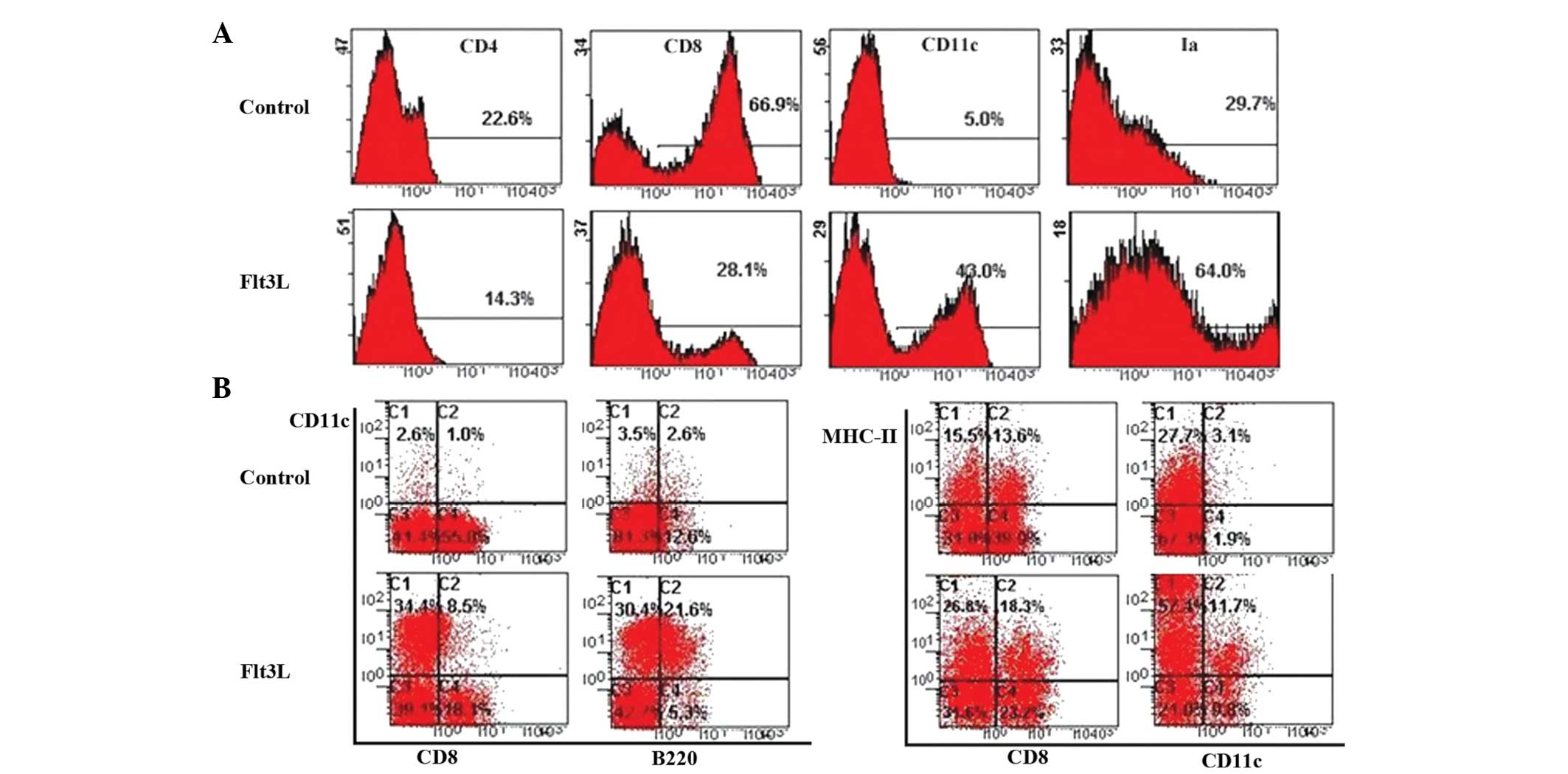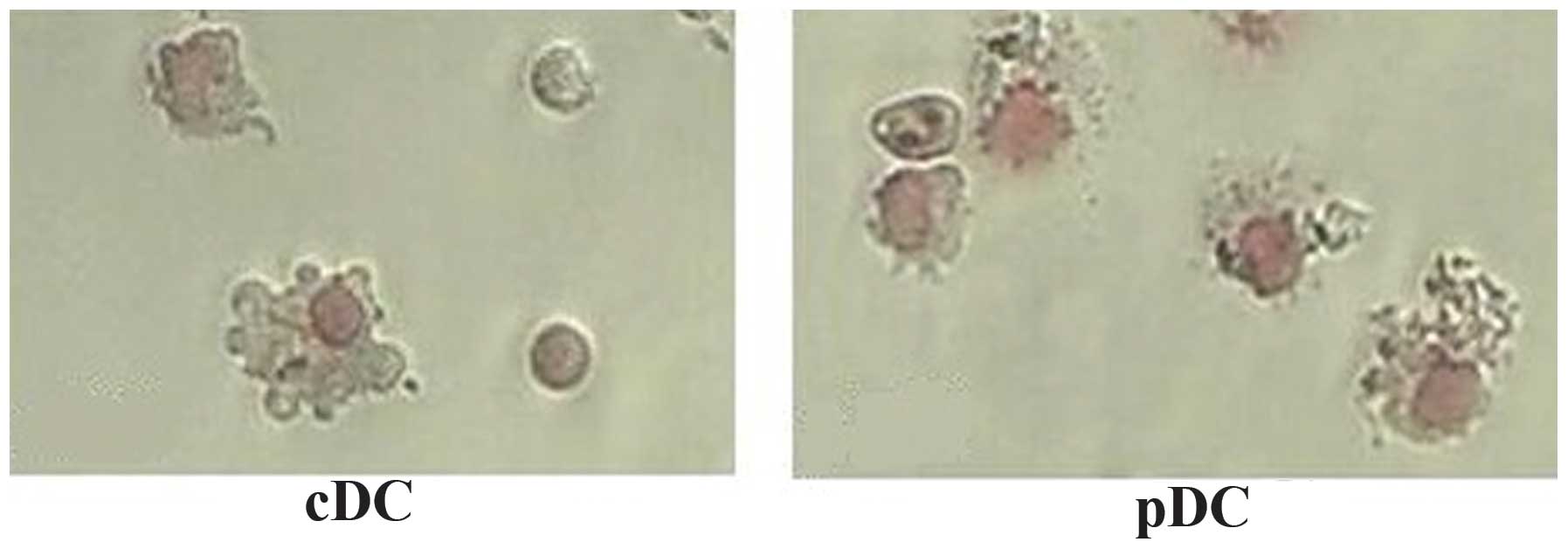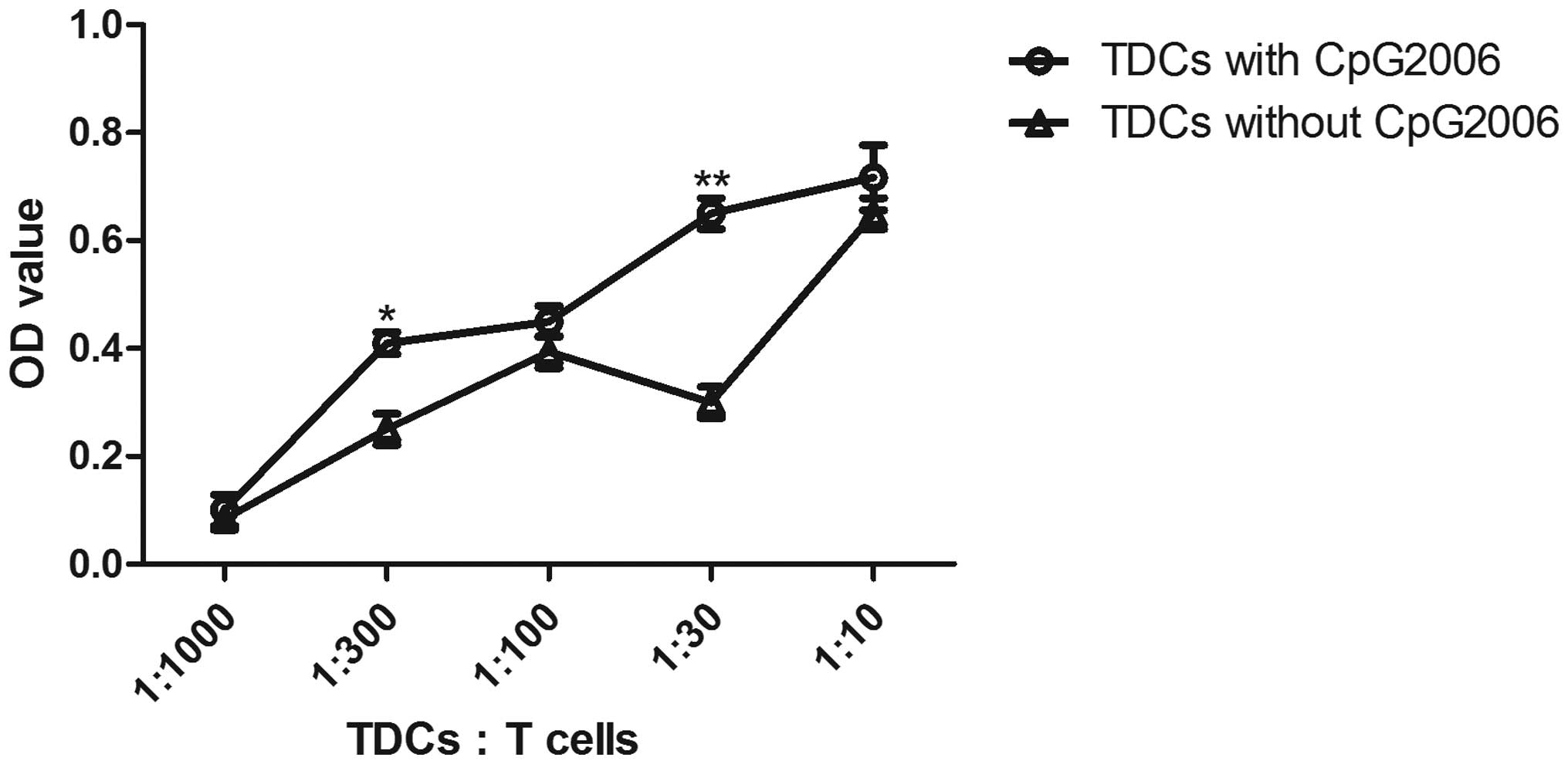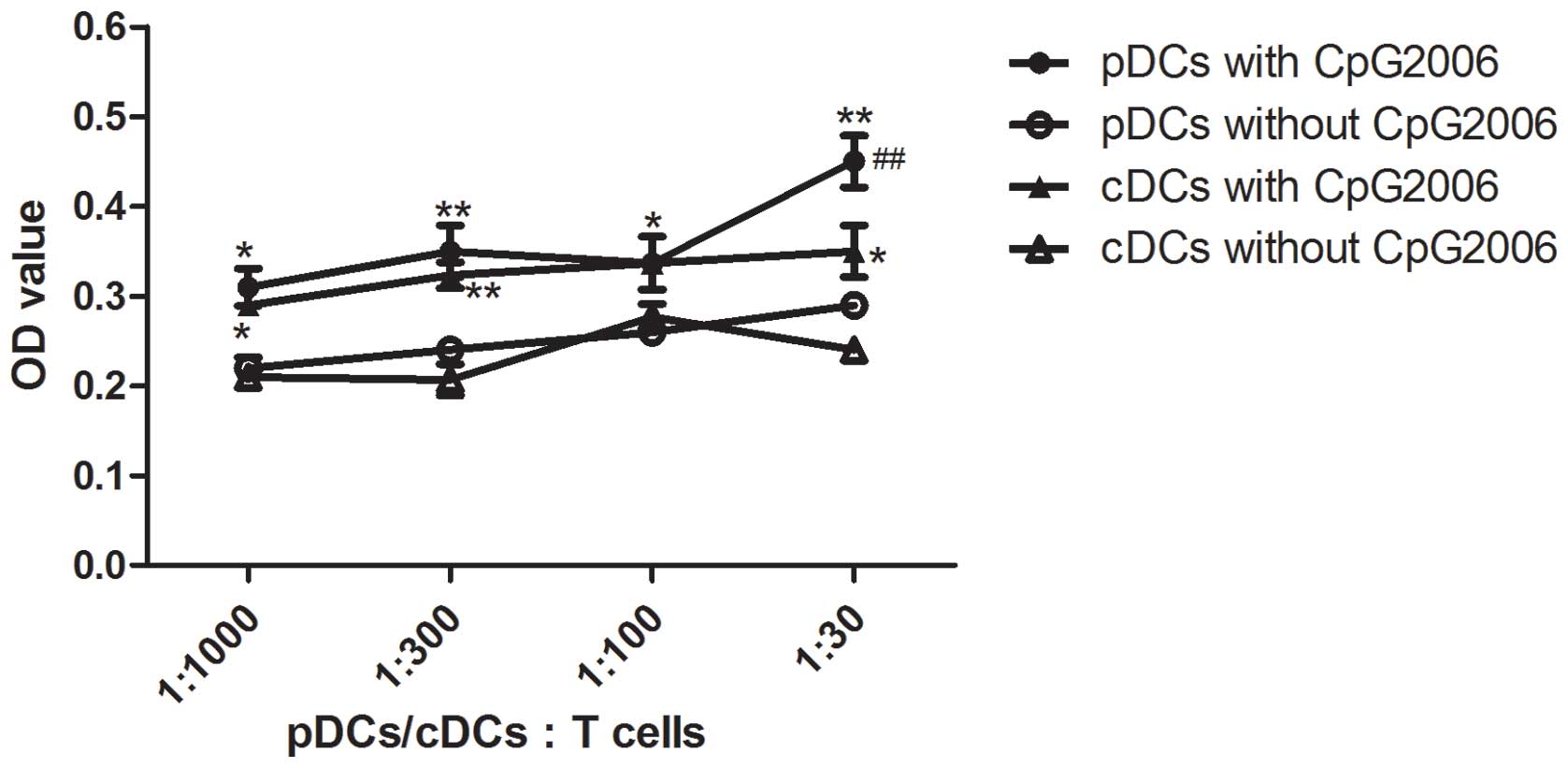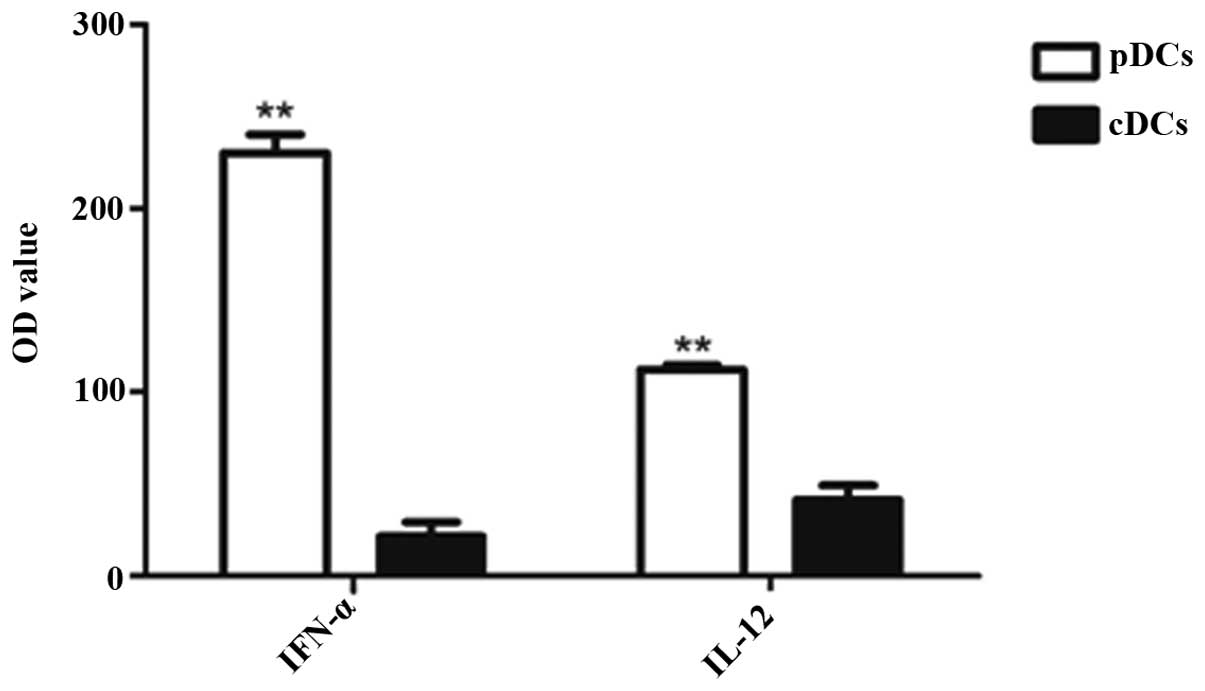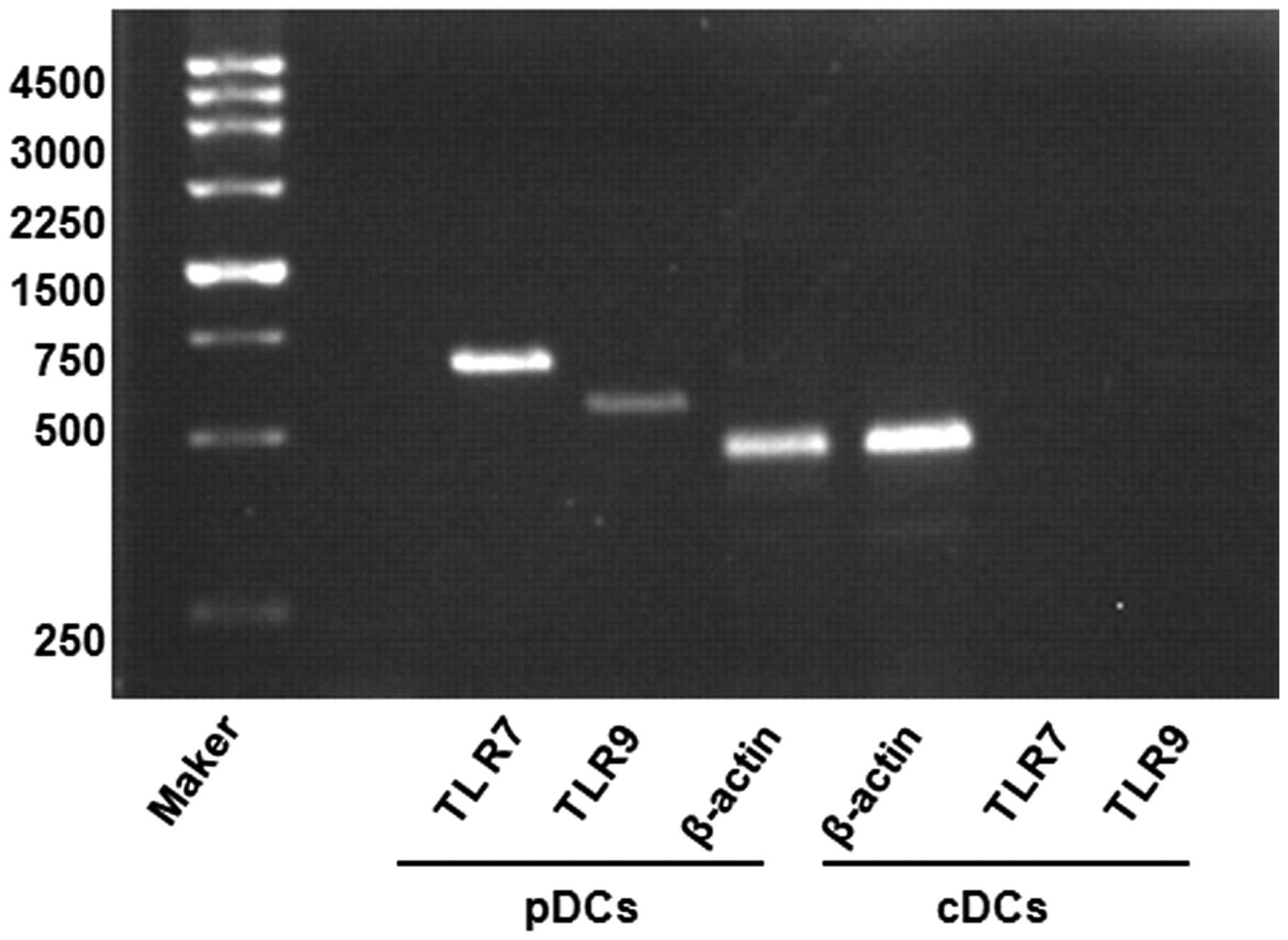|
1
|
Lee HK and Iwasaki A: Innate control of
adaptive immunity: Dendritic cells and beyond. Semin Immunol.
19:48–55. 2007. View Article : Google Scholar : PubMed/NCBI
|
|
2
|
Shortman K and Naik SH: Steady-state and
inflammatory dendritic-cell development. Nat Rev Immunol. 7:19–30.
2007. View
Article : Google Scholar
|
|
3
|
Gilliet M, Boonstra A, Paturel C,
Antonenko S, Xu XL, Trinchieri G, O'Garra A and Liu YJ: The
development of murine plasmacytoid dendritic cell precursors is
differentially regulated by FLT3-ligand and granulocyte/macrophage
colony-stimulating factor. J Exp Med. 195:953–958. 2002. View Article : Google Scholar : PubMed/NCBI
|
|
4
|
Miller G, Pillarisetty VG, Shah AB, Lahrs
S and DeMatteo RP: Murine Flt3 ligand expands distinct dendritic
cells with both tolerogenic and immunogenic properties. J Immunol.
170:3554–3564. 2003. View Article : Google Scholar : PubMed/NCBI
|
|
5
|
Luche H, Ardouin L, Teo P, See P, Henri S,
Merad M, Ginhoux F and Malissen B: The earliest intrathymic
precursors of CD8alpha (+) thymic dendritic cells correspond to
myeloid-type double-negative 1c cells. Eur J Immunol. 41:2165–2175.
2011. View Article : Google Scholar : PubMed/NCBI
|
|
6
|
Ardavin C, Wu L, Li CL and Shortman K:
Thymic dendritic cells and T cells develop simultaneously in the
thymus from a common precursor population. Nature. 362:761–763.
1993. View
Article : Google Scholar : PubMed/NCBI
|
|
7
|
Kadowaki N, Antonenko S and Liu YJ:
Distinct CpG DNA and polyinosinic-polycytidylic acid
double-stranded RNA, respectively, stimulate CD11c-type 2 dendritic
cell precursors and CD11c+ dendritic cells to produce type I IFN. J
Immunol. 166:2291–2295. 2001. View Article : Google Scholar : PubMed/NCBI
|
|
8
|
Diebold SS, Kaisho T, Hemmi H, Akira S and
Reis e Sousa C: Innate antiviral responses by means of
TLR7-mediated recognition of single-stranded RNA. Science.
303:1529–1531. 2004. View Article : Google Scholar : PubMed/NCBI
|
|
9
|
Jarrossay D, Napolitani G, Colonna M,
Sallusto F and Lanzavecchia A: Specialization and complementarity
in microbial molecule recognition by human myeloid and
plasma-cytoid dendritic cells. Eur J Immunol. 31:3388–3393. 2001.
View Article : Google Scholar : PubMed/NCBI
|
|
10
|
Bendriss-Vermare N, Barthélémy C, Durand
I, Bruand C, Dezutter-Dambuyant C, Moulian N, Berrih-Aknin S, Caux
C, Trinchieri G and Brière F: Human thymus contains
IFN-alpha-producing CD11c (−), myeloid CD11c (+) and mature
interdigitating dendritic cells. J Clin Invest. 107:8358442001.
View Article : Google Scholar : PubMed/NCBI
|
|
11
|
Gurney KB, Colantonio AD, Blom B, Spits H
and Uittenbogaart CH: Endogenous IFN-alpha production by
plasmacytoid dendritic cells exerts an antiviral effect on thymic
HIV-1 infection. J Immunol. 173:7269–7276. 2004. View Article : Google Scholar : PubMed/NCBI
|
|
12
|
Fohrer H, Audit IM, Sainz A, Schmitt C,
Dezutter-Dambuyant C and Dalloul AH: Analysis of transcription
factors in thymic and CD34+ progenitor-derived plasmacytoid and
myeloid dendritic cells: Evidence for distinct expression profiles.
Exp Hematol. 32:104–112. 2004. View Article : Google Scholar : PubMed/NCBI
|
|
13
|
Keir ME, Stoddart CA, Linquist-Stepps V,
Moreno ME and McCune JM: IFN-alpha secretion by type 2 predendritic
cells up-regulates MHC class I in the HIV-1-infected thymus. J
Immunol. 168:325–331. 2002. View Article : Google Scholar
|
|
14
|
Varas A, Vicente A, Sacedón R and Zapata
AG: Interleukin-7 influences the development of thymic dendritic
cells. Blood. 92:93–100. 1998.PubMed/NCBI
|
|
15
|
Adolfsson J, Borge OJ, Bryder D,
Theilgaard-Mönch K, Astrand-Grundström I, Sitnicka E, Sasaki Y and
Jacobsen SE: Upregulation of Flt3 expression within the bone marrow
Lin (−) Sca1 (+) c-kit (+) stem cell compartment is accompanied by
loss of self-renewal capacity. Immunity. 15:659–669. 2001.
View Article : Google Scholar : PubMed/NCBI
|
|
16
|
Maraskovsky E, Brasel K, Teepe M, Roux ER,
Lyman SD, Shortman K and McKenna HJ: Dramatic increase in the
numbers of functionally mature dendritic cells in Flt3
ligand-treated mice: Multiple dendritic cell subpopulations
identified. J Exp Med. 184:1953–1962. 1996. View Article : Google Scholar : PubMed/NCBI
|
|
17
|
O'Keeffe M, Hochrein H, Vremec D, Pooley
J, Evans R, Woulfe S and Shortman K: Effects of administration of
progeni-poietin 1, Flt-3 ligand, granulocyte colony-stimulating
factor and pegylated granulocyte-macrophage colony-stimulating
factor on dendritic cell subsets in mice. Blood. 99:2122–2130.
2002. View Article : Google Scholar : PubMed/NCBI
|
|
18
|
Chen W, Antonenko S, Sederstrom JM, Liang
X, Chan AS, Kanzler H, Blom B, Blazar BR and Liu YJ: Thrombopoietin
cooperates with FLT3-ligand in the generation of plasma-cytoid
dendritic cell precursors from human hematopoietic progenitors.
Blood. 103:2547–2553. 2004. View Article : Google Scholar
|
|
19
|
Suss G and Shortman K: A subclass of
dendritic cells kills CD4 T cells via Fas/Fas-ligand-induced
apoptosis. J Exp Med. 183:1789–1796. 1996. View Article : Google Scholar : PubMed/NCBI
|
|
20
|
Ganguly D, Chamilos G, Lande R, Gregorio
J, Meller S, Facchinetti V, Homey B, Barrat FJ, Zal T and Gilliet
M: Self-RNA-antimicrobial peptide complexes activate human
dendritic cells through TLR7 and TLR8. J Exp Med. 206:1983–1994.
2009. View Article : Google Scholar : PubMed/NCBI
|
|
21
|
Cella M, Sallusto F and Lanzavecchia A:
Origin, maturation and antigen presenting function of dendritic
cells. Curr Opin Immunol. 9:10–16. 1997. View Article : Google Scholar : PubMed/NCBI
|
|
22
|
Romani N, Reider D, Heuer M, Ebner S,
Kämpgen E, Eibl B, Niederwieser D and Schuler G: Generation of
mature dendritic cells from human blood. An improved method with
special regard to clinical applicability. J Immunol Methods.
196:137–151. 1996. View Article : Google Scholar : PubMed/NCBI
|
|
23
|
Zhou LJ and Tedder TF: CD14+ blood
monocytes can differentiate into functionally mature CD83+
dendritic cells. Proc Natl Acad Sci USA. 93:2588–2592. 1996.
View Article : Google Scholar : PubMed/NCBI
|
|
24
|
Kingston D, Schmid MA, Onai N, Obata-Onai
A, Baumjohann D and Manz MG: The concerted action of GM-CSF and
Flt3-ligand on in vivo dendritic cell homeostasis. Blood.
114:835–843. 2009. View Article : Google Scholar : PubMed/NCBI
|
|
25
|
McKenna HJ, Stocking KL, Miller RE, Brasel
K, De Smedt T, Maraskovsky E, Maliszewski CR, Lynch DH, Smith J,
Pulendran B, et al: Mice lacking flt3 ligand have deficient
hematopoiesis affecting hematopoietic progenitor cells, dendritic
cells and natural killer cells. Blood. 95:3489–3497.
2000.PubMed/NCBI
|
|
26
|
Sambandam A, Maillard I, Zediak VP, Xu L,
Gerstein RM, Aster JC, Pear WS and Bhandoola A: Notch signaling
controls the generation and differentiation of early T lineage
progenitors. Nat Immunol. 6:663–670. 2005. View Article : Google Scholar : PubMed/NCBI
|
|
27
|
de Kruijf EJ, Hagoort H, Velders GA, Fibbe
WE and van Pel M: Hematopoietic stem and progenitor cells are
differentially mobilized depending on the duration of Flt3-ligand
administration. Haematologica. 95:1061–1067. 2010. View Article : Google Scholar : PubMed/NCBI
|
|
28
|
Karsunky H, Merad M, Cozzio A, Weissman IL
and Manz MG: Flt3 ligand regulates dendritic cell development from
Flt3+ lymphoid and myeloid-committed progenitors to Flt3+ dendritic
cells in vivo. J Exp Med. 198:305–313. 2003. View Article : Google Scholar : PubMed/NCBI
|
|
29
|
Kim T, Pazhoor S, Bao M, Zhang Z,
Hanabuchi S, Facchinetti V, Bover L, Plumas J, Chaperot L, Qin J
and Liu YJ: Aspartate-g lutamate-alanine-histidine box motif
(DEAH)/RNA helicase A helicases sense microbial DNA in human
plasmacytoid dendritic cells. Proc Natl Acad Sci USA.
107:15181–15186. 2010. View Article : Google Scholar
|
|
30
|
Beignon AS, McKenna K, Skoberne M, Manches
O, DaSilva I, Kavanagh DG, Larsson M, Gorelick RJ, Lifson JD and
Bhardwaj N: Endocytosis of HIV-1 activates plasmacytoid dendritic
cells via Toll-like receptor-viral RNA interactions. J Clin Invest.
115:3265–3275. 2005. View Article : Google Scholar : PubMed/NCBI
|
|
31
|
Heil F, Hemmi H, Hochrein H, Ampenberger
F, Kirschning C, Akira S, Lipford G, Wagner H and Bauer S:
Species-specific recognition of single-stranded RNA via toll-like
receptor 7 and 8. Science. 303:1526–1529. 2004. View Article : Google Scholar : PubMed/NCBI
|



